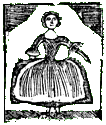“Turtius Bass and wife are parted.”
Turtius Bass and wife are parted. He has sold the House and land which his Sons liv’d in and divided his Estate into four parts, given his wife one fourth part, one half to his two Sons. The remainder he has taken to support himself and Nell Underwood in their Perigrinations to the Eastward [i.e., Maine] whither he is going he says to settle.This letter tells us that in 1785 “Turtius Bass” had a wife and two sons, at least one of them married with a child and the other named Seth. Page 55 of this 1835 genealogy indicates that “Turtius” was most likely the Samuel Bass born in 1737, son of Seth and Eunice Bass. He married Alice Spear in 1758 and had sons Jeriah in 1760 and Seth in 1761. That book says nothing of Nell Underwood. It also says nothing about when this Samuel Bass died, indicating that his relatives in Braintree had lost track, or chosen to lose track, of him.
And as he is going into a new country, tis proper he should take a young person to help People it, and her abbillity to do it She has given ample proof off by presenting somebody (she swore them upon Leonard Clevverly [1758-1828]) with a pair of Twins last winter. She liv’d in Mr. Bass’s Family—but as they both dy’d she was at Liberty to pursue her Business as Housekeeper in some distant part of the State as well as at Braintree, and who would be Maid when they might be mistress?
Mr. Bass was so generious to the Girl, that he keept her in his house to lay in, and gave Mr. [Royall] Tyler a handsome Fee as Counsel for her in case Mr. Cleaverly should deny the charge which he did most solemnly. In this case the woman has the advantage in law. He was oblig’d to enter into Bonds, but the children dying, and Mr. Tyler not appearing, he took up his bonds and Mr. Bass was oblig’d to bear all the charges.
Mrs. Bass is in great trouble. Seth is mov’d into the House with her, and the other Son with his wife and child are mov’d seventy mile into the country out of all the noise of it—so much for Scandle.
But this biographical directory from 1897 suggests that Samuel Bass settled in Wilton, Maine, and his son Jeriah eventually brought his family there, too. After another century, their descendant George H. Bass was a leading local shoe manufacturer.
As for Alice Bass, neighbors John and Abigail Adams bought some of her land in 1788.






